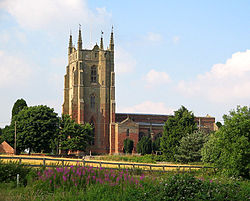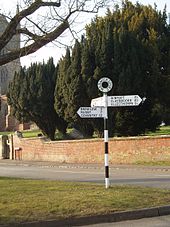- Monks Kirby
-
Coordinates: 52°26′38″N 1°18′58″W / 52.444°N 1.316°W
Monks Kirby 
St Edith's Church
 Monks Kirby shown within Warwickshire
Monks Kirby shown within WarwickshirePopulation 434 (2001) OS grid reference SP4683 Parish Monks Kirby District Rugby Shire county Warwickshire Region West Midlands Country England Sovereign state United Kingdom Post town RUGBY Postcode district CV23 Dialling code 01788 Police Warwickshire Fire Warwickshire Ambulance West Midlands EU Parliament West Midlands UK Parliament Nuneaton List of places: UK • England • Warwickshire Monks Kirby is a village and civil parish in north-eastern Warwickshire, England. The population of the parish is 434 (2001 census).[1]
Monks Kirby is located around one mile east of the old Fosse Way, around 8 miles north-west of Rugby, seven miles north-east of Coventry and six miles west of Lutterworth. Administratively it forms part of the borough of Rugby. One of the largest and most important villages in this part of Warwickshire in the medieval and early modern period, by the nineteenth century Monks Kirby had become a small farming community. Monks Kirby is today an attractive, wealthy commuter village with many residents working in Coventry, Birmingham, Leicester and London.
Contents
History
Monks Kirby is dominated by the priory church of St Edith, a site of Christian worship since at least the 10th century AD.
The priory is long since ruined but the church remains, seeming out of proportion to the size of the village. The first church at the site was founded in 917 by Ethelfleda, daughter of Alfred the Great. After the Norman Conquest, King William gave vast areas of land to one of his knights, Geoffrey de la Guerche, a Breton, who had supported him in the invasion of England. A carved stone head still visible at the back of the church is said to be of Geoffrey de la Guerche. Geoffrey rebuilt the ruined Saxon church and dedicated it to the Blessed Virgin Mary and St Denis the Patron Saint of France in 1077 (the church's 900th anniversary was celebrated in 1977). He also endowed it with a Benedictine prior and seven monks from the abbey of St Nicholas at Angers, France. The church was substantially rebuilt in around 1380 and in 1415 Henry V transferred the priory to the Carthusians of the Isle of Axholme, Lincolnshire.[2]
The 100 years war with France also caused the dedication of the church to be changed to St Edith of Polesworth, a Warwickshire Saint (the connection with St Denis was revived in the 19th century for the chapel of St Denis, built in the neighbouring village of Pailton).
The Carthusian Order having been dissolved in 1538 in the Reformation, the priory and its property was given by the King to Thomas Mannyng, Bishop of Ipswich. The property changed hands several times over the course of the following 80 years until it arrived with Basil, Lord Feilding who was created Earl of Denbigh in 1622. The Denbigh family owned most of the village and the land around it until the mid-twentieth century, and they continue to live nearby (see below).
Meanwhile, the rectory and the advowson of the vicarage were granted by Henry VIII to his foundation of Trinity College Cambridge in December 1546. Trinity College continues to be involved in the church's affairs today but divested itself of substantial landholdings around Monks Kirby following the Second World War.
Up to the industrial revolution and the coming of the railways, Monks Kirby was one of the most important villages in this part of Warwickshire. Early in the 17th century the hundred of Knightlow (one of the county's main administrative divisions, which included all of modern day Coventry) was reorganized on a basis of four High Constables' divisions — Kenilworth, Monks Kirby, Rugby, and Southam. Monks Kirby retained its high constable until 1828.[3]
The ecclesiastical parish of Monks Kirby still includes several neighbouring villages: Pailton, Stretton-under-Fosse, Newbold Revel, Copston and Easenhall. Historically, there was also a further hamlet in the parish of Monks Kirby: the village of Cestersover, abandoned in the middle ages.
Roman Catholic Community
There is also the Catholic St Joseph's Church, built in the late 1980s. The cemetery on the outskirts of Monks Kirby is a Roman Catholic burial site, originally a private graveyard for the Feilding family (the family of the Earls of Denbigh, many of whom practice Roman Catholicism following the conversion of the 8th Earl in 1850). Today the Catholic cemetery is used for burials from St Joseph's.
The Earls of Denbigh
The Earl of Denbigh - whose family once owned most of the homes in the village and much of the land around it - lives on his ancestral estate Newnham Paddox neighbouring the village. The large mansion house of Newnham Paddox was demolished after the family was hit by heavy death duties in 1952, though landscaped gardens designed by Capability Brown remain. The current Earl lives in smaller house on the same site.
Pubs
Monks Kirby has two pubs, the Denbigh Arms which is next to the church and the Bell Inn, at the end of Bell Lane. The Denbigh Arms hosts a popular Italian Pizza night on the 2nd Tuesday each month.
See also
References
- Warwickshire Towns & Villages, by Geoff Allen (2000) (ISBN 1-85058-642-X)
- ^ ONS Neighbourhood Statsitics
- ^ "House of Carthusian Monks 30. The Priory of Axholme (reproducing text from "A History of the County of Lincolnshire, Vol. 2", Page, pub 1906)". British History Online. http://www.british-history.ac.uk/report.aspx?compid=38016. Retrieved 20 December 2009.
- ^ "'The hundred of Knightlow', A History of the County of Warwick: Volume 6: Knightlow hundred (1951)". British History Online. http://www.british-history.ac.uk/report.aspx?compid=57082. Retrieved 3 January 2011.
External links
Categories:- Villages in Warwickshire
Wikimedia Foundation. 2010.


